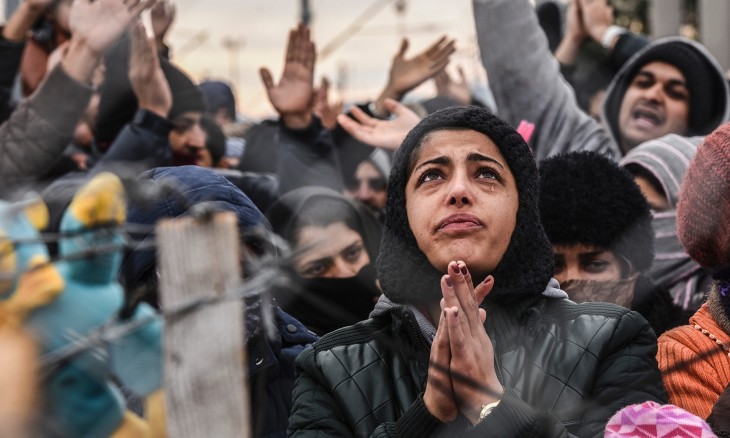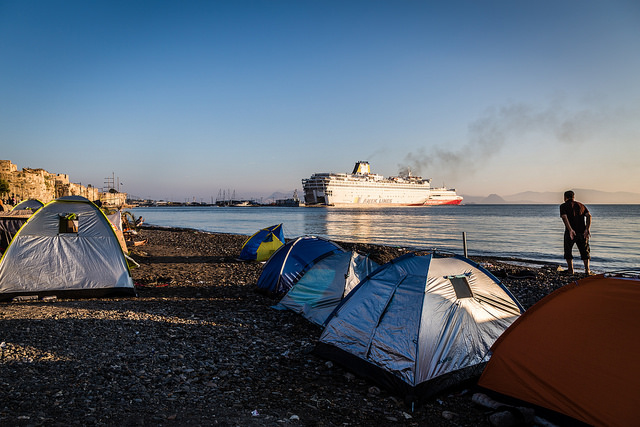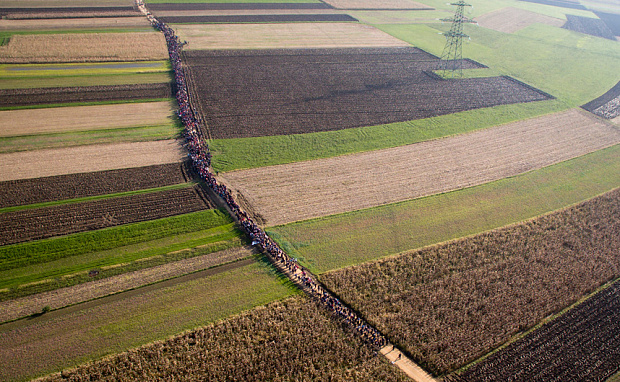Pathway to Peaceful Development
An Architect’s non-architectural approach to city revitalisation in the age of a Refugee-Wave

Image: Photograph by Armend Nimani/AFP/Getty1
The world is currently facing the largest mass migrations since the Second World War. Many of the immigrants are fleeing from war-torn conflicts and persecution. According to UNCHR there are 4.3million refugees as a result of the Syrian Civil war, since 2011. Neighbouring countries in the Middle East and North Africa will be the first destination for resettlement for a large percentage of the refugees. However many will continue their journey to North towards Europe in seek of a better life. With one of Europe’s strongest economies, and a good welfare system Germany is by far one of the most popular destinations for refugees. Germany alone is expected to receive 1million refugees over the coming months.
How can Europe adequately respond to accommodate with this large influx of people? And more importantly how can European architects have a positive contribution/impact to alleviate this social issue? Will architecture be a part of the long-term sustainable solution?
As a response to the WWII the international community of the UN Member States drafted the Universal Declaration of Human Rights. This was done to recognise the dignity of life of all members of the human family, as a foundation for justice and world peace.
I would like to bring to your attention a few of the points that I believe are relevant in the context of the current refugee crisis:
“Article 3.
Everyone has the right to life, liberty and security of person.
Article 14.
(1) Everyone has the right to seek and to enjoy in other countries asylum from persecution.
(2) This right may not be invoked in the case of prosecutions genuinely arising from non-political crimes or from acts contrary to the purposes and principles of the United Nations.
Article 25.
(1) Everyone has the right to a standard of living adequate for the health and well-being of himself and of his family, including food, clothing, housing and medical care and necessary social services, and the right to security in the event of unemployment, sickness, disability, widowhood, old age or other lack of livelihood in circumstances beyond his control.”
All the undersigned member states have agreed to uphold these values. These ideals have also been re-iterated earlier this year the UN General Assembly in NY, regarding the post-2015 development agenda with the outcome of the 2030 Agenda for Sustainable development. According to Leila Farha, a UN special rapporteur: “Under international human rights obligations, housing is not a commodity; it is a human right.”
I believe the global community must share the responsibility for the welfare of the refugees, both at a government level and at a citizen level. As an architect I think we have a moral and ethical responsibility to serve all members of society to the best of our abilities.
One of the challenges in the face of the refugee crisis will be how to provide adequate living conditions, and include these new migrants in the existing urban fabric. Refugee camps may provide a temporary solution for shelter in a temperate climate. But this is not a long-term option for a dignified life, and will not resist the elements in Central or Northern European conditions in winter.

Image: Tents on Kos Island6
Since the Global Financial Crisis in 2008, there has been slow economic growth in the EU region, which has halted new building projects in some countries due to lower market demand. Also as unemployment rose, especially among the younger generation, some people needed to move back in with their families in order to afford housing. Houses with unpaid mortgages were re-possessed by the banks, leaving parts of new developed areas empty in some Spanish towns. From this we can see that the issue is not simply the lack of housing stock itself, but rather amount of affordable housing for the lower and middle-class.
I do not necessarily building more housing is the solution immediately. It is a matter of better re-distributing the housing options in the current existing urban fabric. Creating good quality architecture is something that often takes a long time and resources. Also I do not think that mass social housing in cultural enclaves in the sub-urban periphery is a good option. These types of housing can lead to social isolation, and limited access to participate in the society.
A non-for-profit crowd-funded organization called “Refugees Welcome” aims to integrate refugees in private accommodation options provides an inclusive approach. Other added benefits and that they can learn the language faster, and adjust to their new environment more easily.
Housing one only one of the factors that contribute to a stable life. Other factors that are essential to human development and capacity building are, allowing the individual to acquire knowledge and skills. Therefore it is important that new migrants are able to live and have access to education, in order to become an active member of society. The sooner a person is given the opportunity to obtain gainful employment, the more sustainable it is economically for the individual as well as for the society as a whole.
Therefore the location of accommodation and proximity to amenities for daily life is of a great importance as well. When people are geographically separated from others based on race, or religion, this is known as the ‘ghetto effect’. These areas can often have higher incidents social and economic problems due to the disadvantages created by a high concentration of vulnerable people.
Inequality can have severe consequences on the urban landscape and its citizens. ‘In an equal city it is more difficult to get access to housing, healthcare, education and transport. Inequality is connected to higher crime and murder rates, a reduction in social mobility and the decreased likelihood of voting in elections. It also results in increased levels of mental health problems, teenage pregnancies, obesity, poor exam results, and most perilous of all, it lowers life expectancy.’
As an immigrant of Egyptian-American descendants, I grew up in a Norwegian small town in the Arctic circle. Although I learned the language quickly and made many friends, I always felt that I was perceived as an “other” or an “outsider” to Norwegian society. I am sure that the world has changed with increasing globalization, since my family immigrated to Norway in 1988. However I can imagine that some refugees might feel the same way, if they were located in a small rural European town with strong ethnic cohesion. In my adulthood, I have always preferred to live in larger multicultural cities, where there is a diverse population.
Some European governments are proposing to distribute the new refugee populations across the country, into more rural towns in addition to the metropolitan areas. Although this might be appropriate from a social and economic perspective, in terms of resource distribution, I am slightly concerned that this might put some refugees at a higher risk of incidents of racism. The German Ministry of Interior said there were 170 attacks on refugee centers in 2014, a three-fold increase from the previous year. The influx of refugees in Europe is controversial, not all countries and citizens are as welcoming. There is not a unanimous response how to best handle the wave of refugees in a beneficial way for all parties involved.
Conclusion
I have spent most of this text discussing the basic physiological needs that need to be met in order to ensure survival, such as shelter, food, and healthcare. Architects livelihood is generally focussed around issues of providing shelter for people, and other spatial concerns. Granting that this is an important pursuit for society, I would like to mention that this is considered on of the basic level in Maslow’s hierarchy of needs, for personal development and self-actualization.
I am neither a psychologist nor a sociologist, but I believe that the growth and development and growth of society must be intrinsically linked to the realized potential of the individual members of that society. I would therefore encourage architects, citizens, and policy makers alike to collaborate in finding a holistic solution on how to include all people of the society in future planning and projects.
“A nation’s greatness is measured by how it treats its weakest members.” ~ Mahatma Ghandi
Personally I do not know when the Syrian war will end, or when it will be safe for people to live peacefully there. Even at that time in the future, it might take years or decades to re-build the country. For the time being I hope that the European and worldwide community can make space in their cities for the Syrian refugees, since the scale of this humanitarian crisis cannot be ignored.
Essentially I think that the universal aim of all people is to seek a better life for themselves, and their family.
Historically when people have fled from war, often they will never return to their country of origin, due to multiple factors, persecution, trauma, economic opportunity, resettling their life in a stable environment. I think we can safely assume that the same thing will be the case for the Syrian refugees. So, the sooner we can accommodate them in their new countries, the better result will be for everyone.

Image: A column of migrants move through the fields after crossing from Croatia, in Rigonce, Slovenia. Photo: AP Photo/Darko Bandic12
References:
- Jane Dudman (2015) UN Envoy: Europe face daunting task on refugees but housing is a human right [online] Available from:
https://www.theguardian.com/housing-network/2015/dec/05/un-envoy-europe-refugees-housing-human-right-leilani-farha
[Accessed on 15.December 2015] - Wikipedia (nd) [online] Available from:
https://en.wikipedia.org/wiki/Refugees_of_the_Syrian_Civil_War
[Accessed on 15.December 2015] - United Nations, (1948) The Universal Declaration Human Rights, [online] Available from:
http://www.un.org/en/universal-declaration-human-rights/
[Accessed on 16.December 2015] - United Nations (2015) Draft outcome document of the United Nations summit for the adoption of the post-2015 development agenda, [online] Available from:
http://www.un.org/ga/search/view_doc.asp?symbol=A/69/L.85&Lang=E
[Accessed on 16.December 2015] - J. Dudman (2015) UN Envoy: Europe face daunting task on refugees but housing is a human right [online] Available from:
https://www.theguardian.com/housing-network/2015/dec/05/un-envoy-europe-refugees-housing-human-right-leilani-farha
[Accessed on 15.December 2015] - M. Albahari, (2015) Fatal Distractions: Mediterranean Migrants and the War on Human Smuggling [online] Available from:
http://councilforeuropeanstudies.org/critcom/fatal-distractions-mediterranean-migrations-and-the-war-on-human-smuggling/
[Accessed on 17.December 2015] - Refugees Welcome (nd), [online] Available from:
http://www.refugees-welcome.net/#countries
[Accessed on 16.December 2015] - L. Hollis, (2013), Cities are good for you: The Genius of the Metropolis, Bloomsbury Publishing, p. 173
- Refugees Unwelcome: The Fight over Germany’s Surge in Refugees (2015), Available from: [Accessed on 16.December 2015]
- Wikipedia (nd) [online]
https://en.wikipedia.org/wiki/Maslow%27s_hierarchy_of_needs
, [Accessed on 18.December 2015]
Pathway to Peaceful Development is a project of IaaC, Institute for Advanced Architecture of Catalonia developed at Master in Advanced Architecture, in 2015-2016 by:
Student: Noor El-Gewely
Faculty: Gonzalo Delacámara